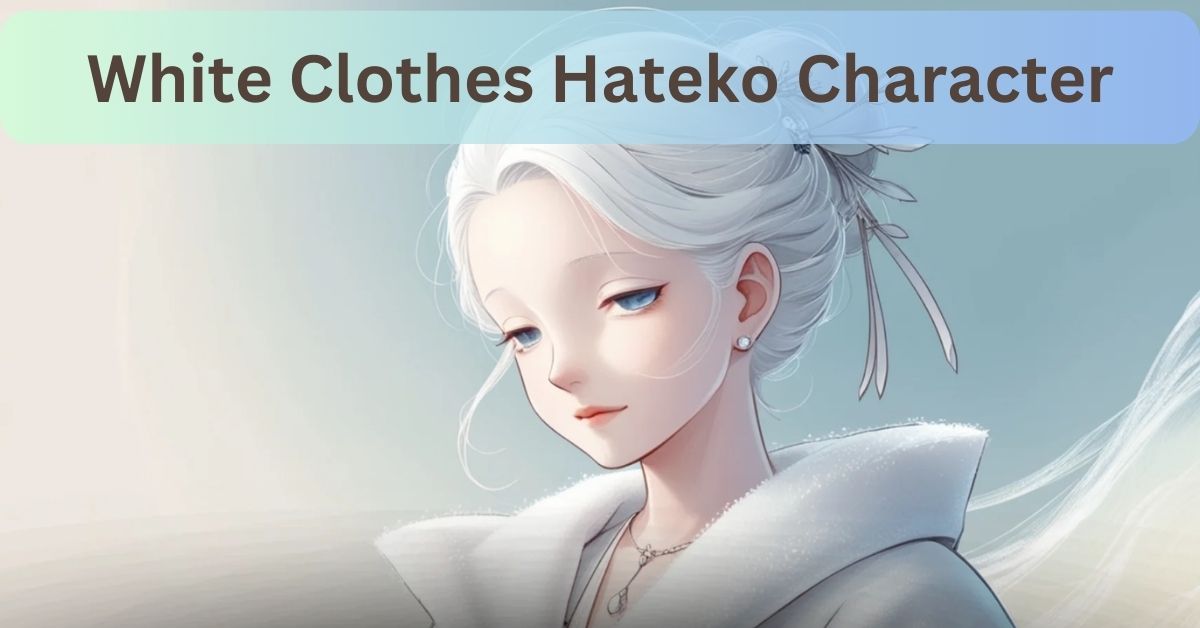White Clothes Hateko Character-A Symbol of Contrasts and Depth
Characters in storytelling often reflect society, identity, or even the human psyche. Among these unique personas is the enigmatic “White Clothes Hateko” character, an archetype that has intrigued audiences for its stark duality and intricate depth.
This article delves into the origins, symbolism, and cultural impact of the White Clothes Hateko character, shedding light on why this figure resonates powerfully in literature, anime, and other narrative mediums.
Origins and Design:
Emerging from the vibrant anime and manga scene, the Hateko character is distinguished by its all-white attire, symbolizing purity and simplicity. Compared to other characters in the show, the character’s design is simple and clean-cut. Their clothes are simple, yet people immediately know who Hateko is. The clothing design is informed by Japanese dress, and this is accented by an element of classical as well as current fashion.
Key Traits of the Hateko Archetype:
The Hateko character archetype is distinct due to its combination of visual aesthetics and deep psychological complexity. Here are some defining traits:
- Tragic Backstory: White Clothes Hateko characters often carry a history of loss, betrayal, or failure. This backstory adds layers to their demeanor and choices.
- Quiet Strength: They may look sensitive or shy, but they can fight life’s challenges, bounce back, and get back on track.
- Moral Ambiguity: Their actions or decisions can sometimes be unethical, giving them the realistic aspect of being human yet not easily predictable.
- Connection to Nature or Mysticism: Hateko is often linked to themes of spirituality, supernatural abilities, or a profound bond with nature.
Positive Connotations:
- The white outfit is generally clean and associated with the untainted character, similar to emotions such as endearing warmth, security, and reliability. This association can make the character relatable and endearing to many viewers.
Negative Connotations:
- At times, white might be associated with sterility, lack of people around, or even detachment – which at some point might be linked to coldness. This is particularly pronounced when the character is juxtaposed with other characters wearing vibrant colors.
- Cultural interpretations significantly influence the perception of the character. In some cultures, white is associated with mourning or death, which can create a sense of unease or even fear.
Popularity and Cultural Impact:
Hateko’s popularity can be attributed to several factors:
- Visual Appeal: The striking white attire stands out, capturing attention and setting trends in fashion circles.
- Relatable Traits: Themes of resilience and hope resonate with a broad audience, fostering a deep emotional connection.
- Social Media Presence: Both Instagram and TikTok are swarming with drawings and cosplay, making Hateko more famous and significant than ever.
- Merchandising: Fans of the character can buy various goods—from the clothes they wear to accessories—to show that they like him.
Controversies and Discussions:
Despite widespread acclaim, Hateko has been the subject of debates concerning representation and cultural implications. Critics argue that certain design elements may perpetuate stereotypes, while discussions about the authenticity of various adaptations continue within fan communities. These conversations reflect broader societal dialogues about character development and inclusivity in popular culture.
Famous Examples of White Clothes Hateko Characters:

Though the archetype isn’t confined to one specific character, many creations in modern storytelling reflect elements of White Clothes Hateko:
- Yuki Nagato from “The Melancholy of Haruhi Suzumiya”: Her stoic demeanor and white school uniform underscore her dual role as a seemingly ordinary girl and a mysterious, otherworldly entity.
- Saber from “Fate/Stay Night”: Clad in light-colored armor, Saber’s noble yet tragic backstory mirrors the purity and sorrow of the Hateko archetype.
- Chi from “Chobits”: Her white dress and innocent demeanor belie her complex role as an artificial being seeking purpose.
Character Backstory and Themes:
Hateko’s narrative is rooted in themes of resilience and hope. The character’s backstory involves overcoming adversity and embodying strength and determination. This relatability has endeared Hateko to fans who see their struggles mirrored in the character’s journey.
Creating a White Clothes Hateko Character:
Writers and creators can develop compelling Hateko-like characters by focusing on:
- Layered Personalities: Avoid making the character one-dimensional. Their depth should unfold gradually, keeping audiences engaged.
- Symbolic Attire: The choice of white clothing should serve a purpose, representing aspects of their identity or struggles.
- Emotional Complexity: Let their actions and emotions oscillate between light and shadow, reflecting their internal conflict.
- Engaging Narratives: Place them in stories where their unique traits shine—whether about redemption, survival, or transformation.
Critiques and Challenges of the Archetype:
While the Hateko archetype is beloved, it isn’t without its critiques.
- Overuse in Media: Overreliance on this archetype can make it predictable, diminishing its impact.
- Stereotyping Vulnerability: Some portrayals risk reducing the character to mere symbols of victimhood or fragility.
- Balancing Complexity: Failing to develop the characters entirely can result in their being overshadowed by other narrative elements.
How can creators innovate this archetype?
Creators can keep the archetype fresh by:
- Adding unexpected traits or backstories.
- Subverting the symbolism of white clothing.
- Placing the character in unconventional or modern narratives.
What is the future of the White Clothes Hateko archetype?
As storytelling evolves, this archetype may take on more nuanced forms, exploring contemporary themes like mental health, identity, and societal expectations while retaining its core symbolism of duality and depth.
Are there criticisms of the archetype?
Yes, some critiques include:
- Overuse: It can feel predictable if used excessively in media.
- Stereotyping: Risk of portraying the character as merely fragile or victimized.
- Shallow Development: The character can lack depth or emotional impact if not well-developed.
Conclusion:
The white clothes of the Hateko character exemplify the dynamic interplay between design, narrative, and cultural resonance in contemporary media. The evolution from an initial design to a symbol takes years of creativity and artistry and is an example of how a few ideas can become an entity people can readily identify with, so much so that they can put their hope in it.
As Hateko continues to inspire and engage audiences worldwide, it is a testament to the enduring impact of thoughtfully crafted characters in pop culture.












































Post Comment